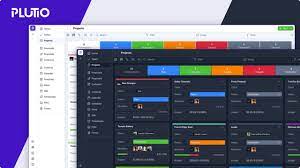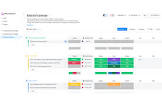Optimise Your Workflow with Task Management Software
The Power of Task Management Software
Task management software has revolutionised the way individuals and teams organise, track, and complete their daily tasks. In today’s fast-paced world, where time is of the essence and productivity is key, having a reliable task management tool can make all the difference.
Efficiency and Organisation
One of the primary benefits of task management software is its ability to enhance efficiency and organisation. By centralising all tasks in one place, users can easily create, prioritise, and assign tasks to themselves or team members. This streamlines workflow and ensures that nothing falls through the cracks.
Collaboration and Communication
Many task management tools offer collaboration features that enable team members to work together seamlessly. With real-time updates, comments, file attachments, and shared calendars, teams can stay connected and informed throughout the project lifecycle. This fosters better communication and teamwork.
Time Tracking and Productivity Monitoring
Task management software often includes time tracking capabilities that allow users to monitor how much time is spent on each task or project. This data can be invaluable for identifying bottlenecks, improving efficiency, and making informed decisions about resource allocation. By tracking productivity metrics, individuals and teams can optimise their workflow for better results.
Customisation and Flexibility
Another advantage of task management software is its customisation options. Users can tailor their task lists, categories, tags, deadlines, reminders, and notifications to suit their specific needs and preferences. This flexibility ensures that the software adapts to different work styles and project requirements.
Security and Data Protection
Data security is a top priority for any organisation using task management software. Leading tools offer robust security measures such as encryption, access controls, backups, and compliance certifications to protect sensitive information from unauthorised access or loss. Users can trust that their data is safe and secure in the software’s hands.
Conclusion
In conclusion, task management software is a powerful tool that empowers individuals and teams to work smarter, not harder. By leveraging its features for efficiency, collaboration, time tracking, customisation, security – users can streamline their workflow, boost productivity levels – ultimately achieving success in their projects.
Maximising Productivity: 8 Essential Tips for Mastering Task Management Software
- Choose a task management software that suits your specific needs and preferences.
- Set clear goals and priorities to effectively organise tasks in the software.
- Utilise features such as deadlines, reminders, and labels to stay on track with your tasks.
- Regularly update and review your task list to ensure nothing falls through the cracks.
- Collaborate with team members by using shared task lists and assigning responsibilities within the software.
- Integrate your task management software with other tools you use for seamless workflow management.
- Take advantage of reporting and analytics tools to track progress and identify areas for improvement.
- Stay flexible and be willing to adjust your task management approach as needed for optimal productivity.
Choose a task management software that suits your specific needs and preferences.
When selecting a task management software, it is crucial to choose one that aligns with your individual requirements and preferences. By opting for a tool that caters to your specific needs, whether it be customisable task lists, intuitive user interface, collaborative features, or robust security measures, you can enhance your productivity and workflow efficiency. The right task management software should seamlessly integrate into your work style and empower you to organise tasks effectively, track progress efficiently, and achieve your goals with ease.
Set clear goals and priorities to effectively organise tasks in the software.
Setting clear goals and priorities is a fundamental tip for effectively organising tasks in task management software. By defining specific objectives and determining the importance of each task, users can streamline their workflow, focus on high-priority items, and allocate resources efficiently. This approach not only helps in staying on track but also ensures that tasks are completed in a timely manner, leading to increased productivity and overall success in managing projects.
Utilise features such as deadlines, reminders, and labels to stay on track with your tasks.
To maximise your productivity and ensure timely completion of tasks, it is essential to leverage the key features offered by task management software. By setting deadlines, creating reminders, and using labels effectively, you can stay organised and focused on your priorities. Deadlines provide a sense of urgency and help you allocate time efficiently, while reminders ensure that important tasks are not overlooked. Labels allow for categorisation and easy identification of tasks, enabling you to streamline your workflow and stay on track with your goals. Implementing these features in your task management process can significantly enhance your efficiency and effectiveness in managing your workload.
Regularly update and review your task list to ensure nothing falls through the cracks.
To maximise the effectiveness of task management software, it is crucial to regularly update and review your task list. By staying on top of your tasks and priorities, you can ensure that nothing falls through the cracks. Regularly reviewing your task list allows you to make adjustments, re-prioritise as needed, and stay focused on the most important tasks at hand. This proactive approach helps maintain clarity and organisation in your workflow, ultimately leading to increased productivity and successful task completion.
Collaborate with team members by using shared task lists and assigning responsibilities within the software.
To maximise productivity and foster effective teamwork, consider utilising task management software to collaborate with team members. By creating shared task lists and assigning responsibilities within the software, you can streamline communication, enhance accountability, and ensure that everyone is aligned on project goals and timelines. This approach not only promotes transparency and coordination but also empowers team members to work together towards a common objective, ultimately leading to successful project outcomes.
Integrate your task management software with other tools you use for seamless workflow management.
To enhance your workflow management, it is advisable to integrate your task management software with other tools you use. By seamlessly connecting your task management software with tools such as calendars, email clients, project management platforms, and communication apps, you can streamline your work processes and ensure that all aspects of your tasks are efficiently coordinated. This integration allows for a more cohesive and organised approach to task handling, enabling you to maximise productivity and effectiveness in managing your daily responsibilities.
Take advantage of reporting and analytics tools to track progress and identify areas for improvement.
To maximise the effectiveness of task management software, it is crucial to utilise reporting and analytics tools to monitor progress and pinpoint areas for enhancement. By leveraging these features, users can gain valuable insights into their workflow, identify bottlenecks or inefficiencies, and make data-driven decisions to improve productivity and project outcomes. Tracking key metrics and performance indicators through reporting and analytics not only provides a clear overview of tasks but also empowers individuals and teams to optimise their processes for greater success.
Stay flexible and be willing to adjust your task management approach as needed for optimal productivity.
To maximise productivity when using task management software, it is essential to remain adaptable and open to adjusting your approach as required. By staying flexible and willing to make changes based on evolving circumstances or feedback, you can ensure that your task management strategy remains effective and efficient. Embracing a mindset of continuous improvement allows you to optimise your workflow, address challenges promptly, and ultimately enhance your overall productivity levels.




